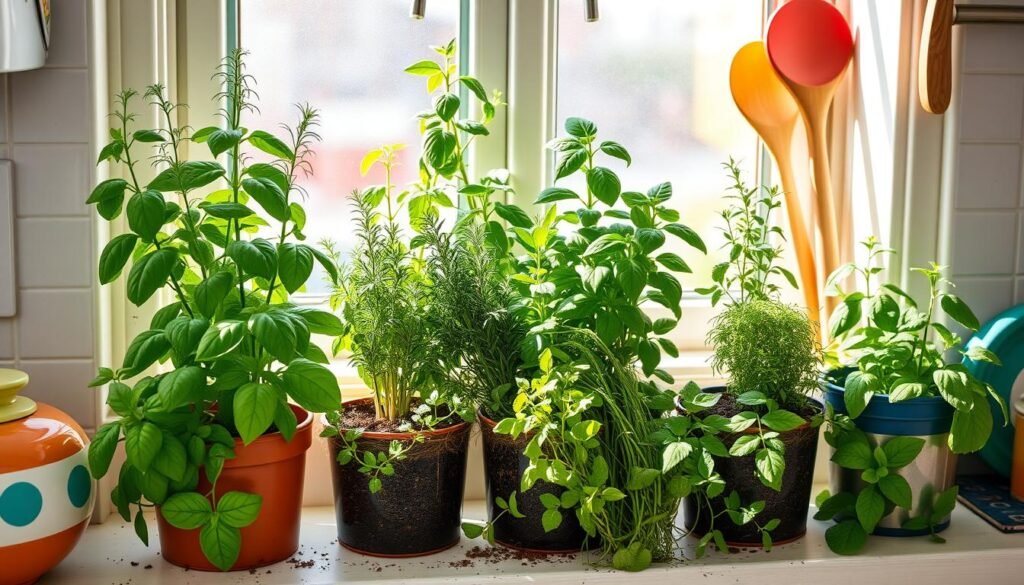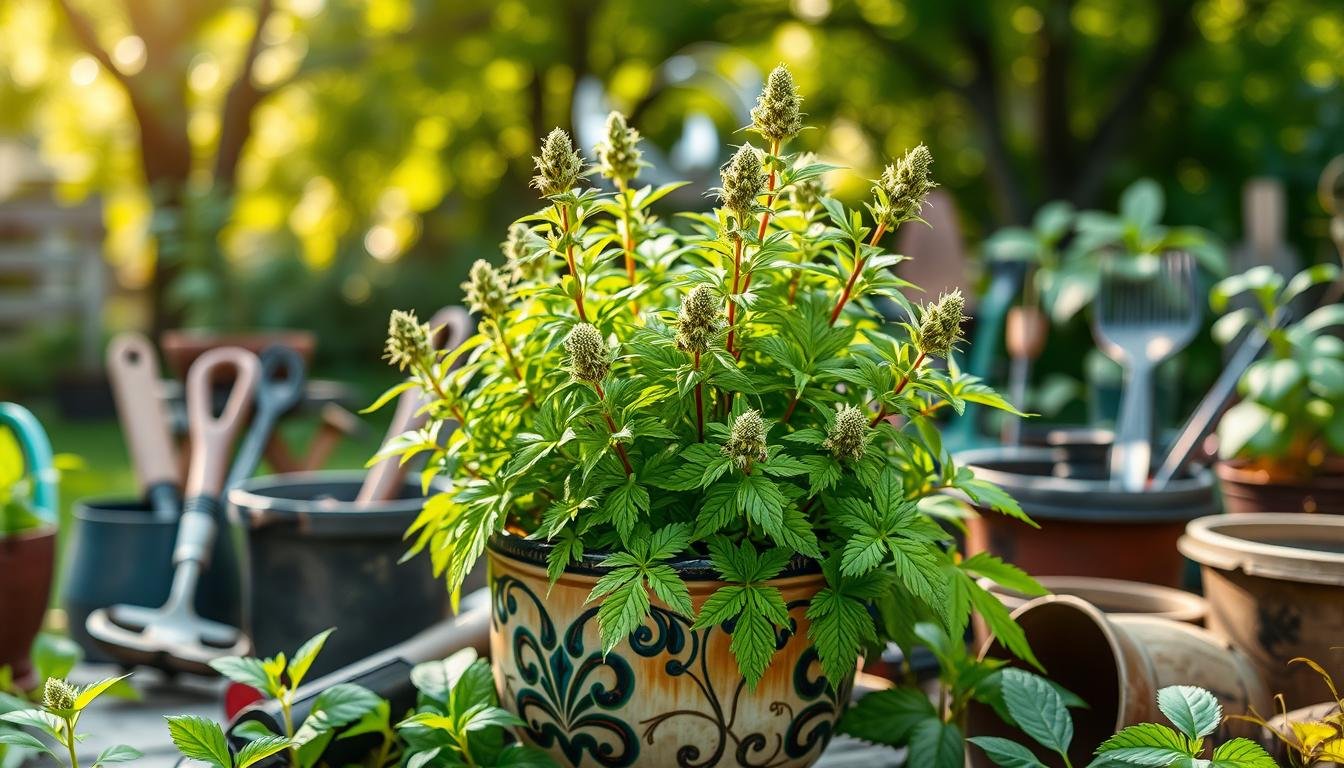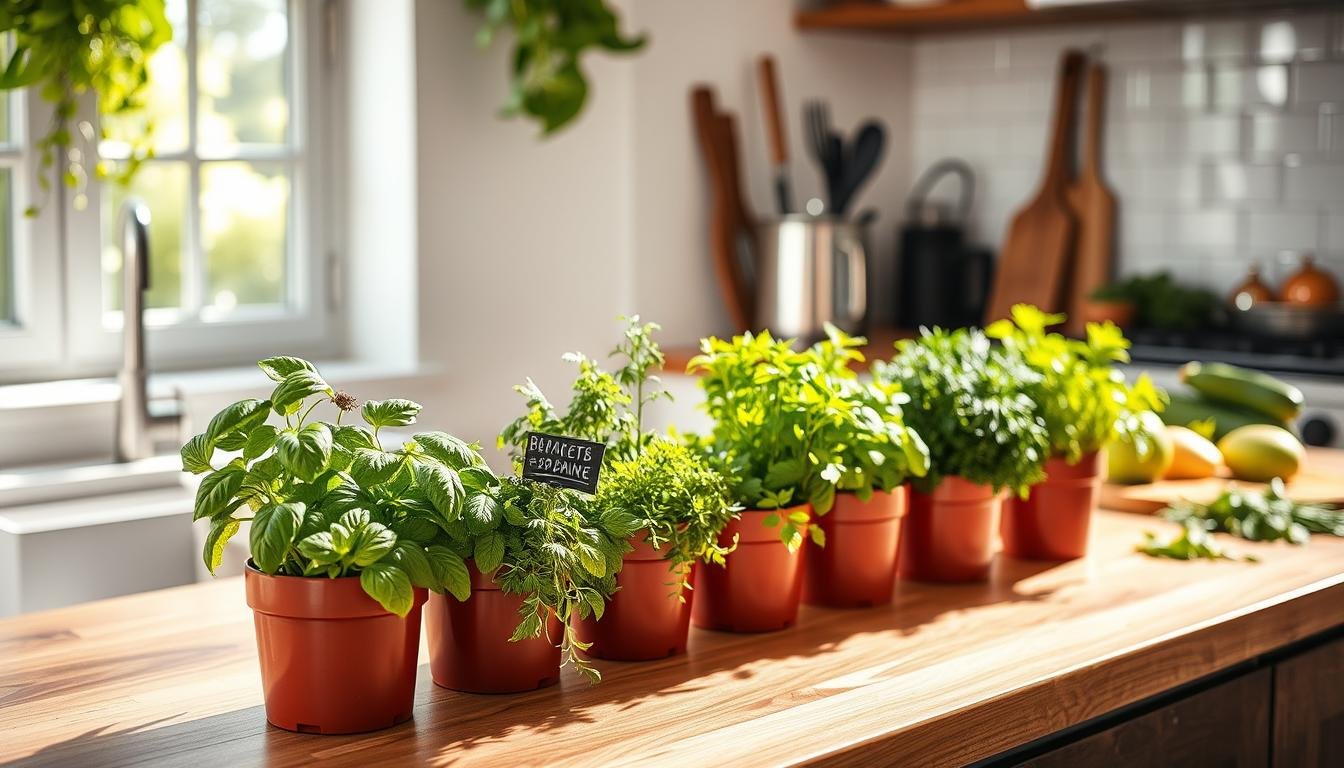Did you know fresh herbs can make home-cooked meals taste over 30% better than dried ones? Having an indoor herb garden diy brings more than just flavor. It turns your kitchen into a place full of delightful smells and bright colors all year. Growing your own kitchen herbs adds culinary value and gives you joy as you care for your plants.
Creating your own indoor herb garden is simple and fun. You’ll love picking your fresh herbs. This DIY project will make your cooking better. Get ready to improve your kitchen’s feel and add taste to your meals!
Key Takeaways
- Fresh kitchen herbs enhance the flavor of meals significantly.
- Creating an indoor herb garden is a rewarding DIY project.
- Indoor herbs improve the ambiance and aesthetics of your kitchen.
- Gardening can provide therapeutic benefits and reduce stress.
- Always choose the right herbs that suit your cooking style.
- Regular maintenance of your herb garden ensures thriving plants.
Benefits of Growing an Indoor Herb Garden
Growing herbs indoors offers many pluses for your kitchen and home life. Fresh herbs make your food taste better. They turn simple meals into amazing eats. Herbs like basil and mint also help clean the air, making your home healthier.
Enhances Flavor in Your Cooking
Adding fresh herbs, such as basil, parsley, and rosemary, brings exciting flavors that dry herbs can’t match. These herbs:
- Make salads and dressings taste better
- Improve marinades and sauces
- Add fragrance to veggies and meats
Fresh herbs not only add flavor but also promote healthy cooking habits. You’ll notice the difference in your meals with them.
Improves Indoor Air Quality
Studies show that herbs like mint and lavender can clean the air. Having an indoor herb garden can:
- Cut down on air toxins
- Boost mood and wellness
- Create a peaceful environment
These facts show how gardening can make you happier and healthier. The benefits spread throughout your life.
| Herb | Flavor Profile | Air Quality Improvement |
|---|---|---|
| Basil | Sweet, aromatic | Reduces indoor pollutants |
| Parsley | Fresh, slightly bitter | Absorbs carbon dioxide |
| Rosemary | Pine-like, robust | Helps to reduce contaminants |
| Mint | Cool, sweet | Improves air circulation |
| Lavender | Fruity, floral | Promotes relaxation |
Essential Herbs to Grow in Your Kitchen
Growing essential herbs in your kitchen does wonders. They make your meals tastier and add greenery. Let’s explore three indoor herbs that can elevate your cooking.
Basil
Basil stands out with its sweet and spicy taste. It’s key in Italian food. It loves warmth and sunlight, thriving on windowsills. It’s great for adding a fresh twist to pasta, salads, and sauces.
Parsley
Parsley is known for its versatility, enhancing the flavor of many dishes. It comes in flat-leaf or curly forms. This herb enjoys moderate light and regular watering, perfect for growing inside.
Rosemary
Rosemary is famous for its strong aroma and flavor. It’s great with roasted and grilled foods. This herb needs lots of sun and well-draining soil. Its leaves also make your kitchen smell amazing.
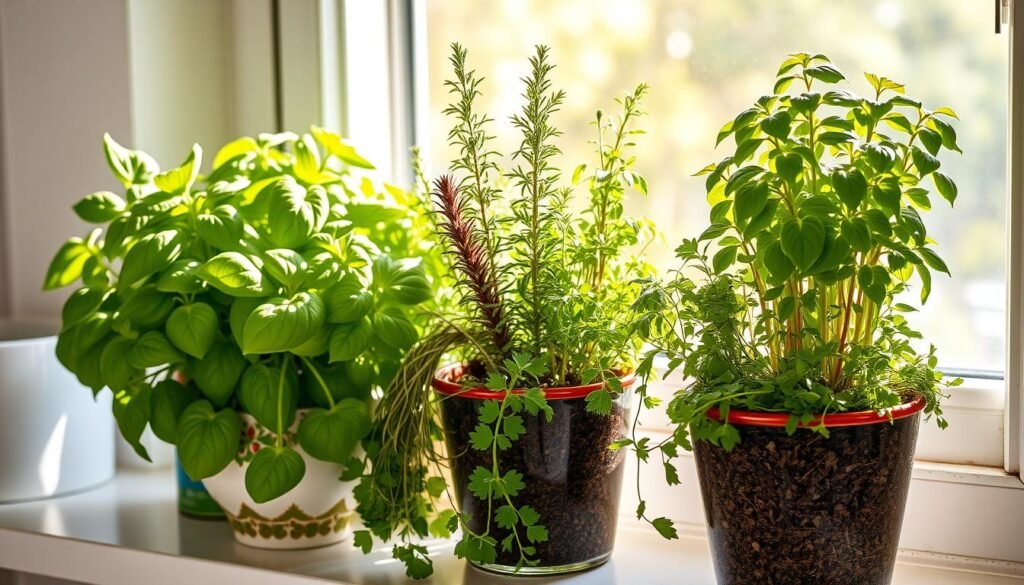
| Herb | Flavor Profile | Perfect Culinary Uses | Optimal Conditions |
|---|---|---|---|
| Basil | Sweet, slightly spicy | Pasta, salads, sauces | Warm, sunny location |
| Parsley | Fresh, slightly peppery | Garnish, salads, soups | Moderate sunlight, consistent watering |
| Rosemary | Robust, pine-like | Roasted dishes, meats | Full sun, well-drained soil |
Choosing the Right Location for Your Herb Garden
It’s key to find the best spot for your herb garden to flourish. Different herbs need different amounts of light. So, knowing how much sunlight your kitchen gets is very important. You can use your windowsill or counter for your garden. Picking the right spot will make your indoor garden better.
Sunlight Requirements
Most herbs for cooking need at least six hours of sunlight every day. Here’s a guide to sunlight needs for some common herbs:
| Herb | Sunlight Needs | Ideal Location |
|---|---|---|
| Basil | Full sun | Sunny windowsill |
| Parsley | Partial shade | Counter space or bright window |
| Rosemary | Full sun | Sunny windowsill |
Knowing your herbs’ sunlight needs helps you place them right in your garden. Look for spots in your kitchen with direct sunlight. Check if those spots are good for your garden.
Choosing Between Windowsill and Counter Space
Many times, a windowsill is the best place for a herb garden. It gets lots of light and looks nice. If your windowsill doesn’t get enough light, use the counter. Make sure it’s near a window that gets a lot of light.
- Windowsill Gardening: Best for herbs needing a lot of sun. It looks good and saves space.
- Counter Space: Good for herbs that don’t need as much light. You can use shelves or multi-level planters for better light.
Try both windowsill and counter to see what works best. Watch how your herbs grow. Then, change their spot if you need to so they grow the best they can.
Indoor Herb Garden DIY: Getting Started
Starting an indoor herb garden needs some planning and gathering supplies. With the right supplies, your indoor garden will thrive. Pick the right herb containers and boxes to make your herbs grow and look good.
Gathering Supplies
Before you start planting, make sure you have everything needed. Here’s a list of important supplies for your herb garden:
- Seeds or starter plants for your preferred herbs
- Quality potting soil suitable for indoor gardening
- Herb containers that promote good drainage
- Planting boxes for larger herb varieties
- Watering can or spray bottle for gentle watering
- Labels to identify your herbs easily
Choosing Containers and Planter Boxes
Choosing the right containers and boxes is crucial for your herbs’ health. Look for containers with holes to avoid water buildup, as this can harm the roots. Here are some materials to consider:
| Material | Benefits | Considerations |
|---|---|---|
| Plastic | Lightweight and inexpensive | May retain heat |
| Ceramic | Attractive and sturdy | Heavier and can crack |
| Wood | Natural look and good insulation | Can rot over time without treatment |
| Metal | Durable and modern | Can overheat and damage roots |
Make a wise choice to ensure a good environment for your herbs. A smart selection will give your indoor herb garden a great start.
Understanding Indoor Gardening Systems
Exploring indoor gardening systems introduces you to different growing methods for your herbs. You can choose between soil-based or hydroponic gardening. Each technique has its benefits and suits various gardening preferences.
Soil vs. Hydroponic Herbs
Soil-based herbs bring a classic style, connecting you with nature by working in the dirt. This method supports a healthy ecosystem for beneficial microorganisms. Meanwhile, hydroponic gardening boosts growth and yield in small spaces. Plants in hydroponic systems get their nutrients from water, making them grow strong.
Benefits of Using Indoor Gardening Kits
Indoor gardening kits make starting easier for new and seasoned gardeners alike. They usually include:
- Pre-packaged nutrients for specific plants
- Seeds or starter plants for indoor use
- Tools for system upkeep
These kits help herbs thrive, making gardening simpler. They’re ideal for enjoying fresh herbs all year. Indoor systems streamline or boost your gardening hobbies.
Utilizing Herb Grow Lights for Optimal Growth
Growing herbs indoors can be hard due to not enough natural light. This is solved by herb grow lights, which give plants the artificial light they need. It’s important to choose and place these lights right to help herbs grow well.
Types of Grow Lights Available
There are several herb grow lights out there, each with pros and cons:
- LED Lights: These are energy-saving and last a long time. They emit light that covers the full spectrum, making them great for all growing stages. This helps with the process of photosynthesis.
- Fluorescent Lights: These are cheap and work well for seedlings and herbs. They give off a useful spectrum of light but can get hot, which might be bad if too close to the plants.
- Incandescent Lights: These are not very efficient, creating more heat than light, and are good only for short-term use. They are usually not recommended for long-term growth because they don’t work very well.
How to Properly Position Grow Lights
Putting herb grow lights in the right spot is key for healthy plants. Keep these tips in mind:
- Hang the lights 6 to 12 inches above the plants to avoid making them too hot.
- Change the height as your herbs grow to keep the light effective.
- Have the lights on for 12-16 hours a day. This simulates natural sunlight, giving the herbs the best light.
Using herb grow lights in your indoor garden helps make sure your herbs are strong and healthy all year.
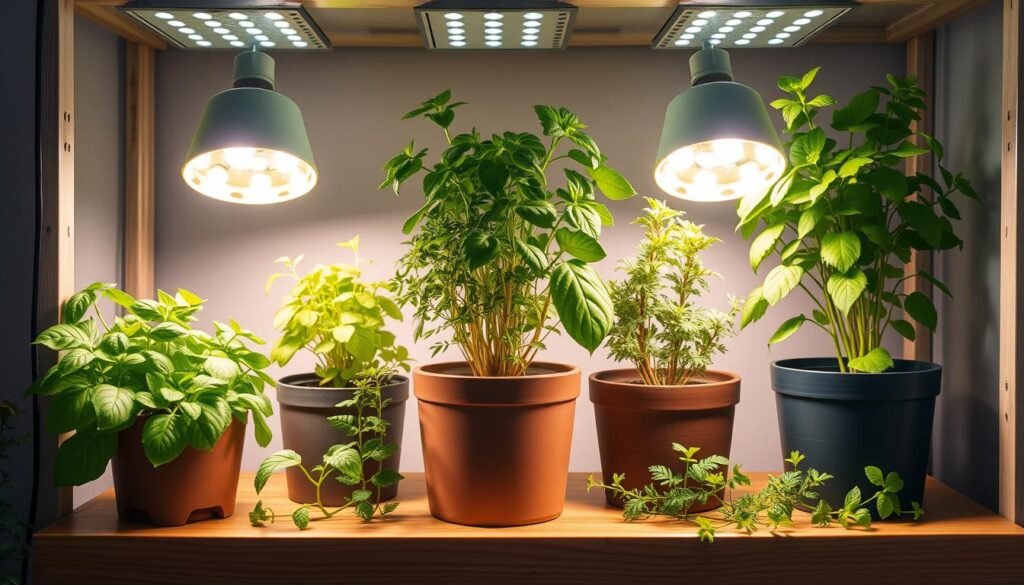
Watering Techniques for Indoor Herbs
Watering right is key to keeping indoor herbs alive and thriving. Knowing about drainage and moisture management improves your plants’ health. We’ll dive into how to water indoor herbs well, focus on why drainage matters, and set up self-watering systems.
Importance of Drainage
Good drainage stops plants from getting too much water, which causes root rot. To grow healthily, remember these tips:
- Use pots with drainage holes to let out extra water.
- Add perlite or gravel to the soil mix for better drainage.
- Check the soil’s wetness often.
How to Create a Self-Watering Herb Garden
Self-watering systems make it easy to keep the moisture just right for indoor herbs. They help your plants get steady water with hardly any effort. Here are steps to build a self-watering herb garden:
- Choose a container that has a place to store water or make one with two containers.
- Put water in the lower container and use something like a cotton rope to connect it to the upper one.
- Put soil and herbs in the top container. The wick will pull up water when needed.
Creating Vertical Herb Gardens in Limited Spaces
If you live in a small place, like an apartment, try vertical herb gardens. They help save space and let you garden. With vertical planters, you can grow more in less space. They make any room look better and keep your herbs right where you need them.
Benefits of Vertical Gardening
Vertical gardening has many pluses. Here are some of the top benefits:
- Space Efficiency: Grow lots of herbs up high, not sprawled out on the floor.
- Enhanced Air Circulation: Better air flow means less mold and fewer pests.
- Aesthetic Appeal: Makes any room look alive and is like having art that grows.
- Ease of Maintenance: It’s easier to take care of since there’s less bending over.
DIY Ideas for Vertical Herb Planters
Making vertical herb gardens can be fun. Check out these DIY ideas:
- Pallet Planters: Fix up wooden pallets and use the gaps for your herbs.
- Hanging Pots: Use the ceiling or walls for hanging pots, saving ground space.
- Wall Mounted Planters: Get holders made to hang plants up high.
- Tiered Shelving: Stack shelves with pots for easy access to a variety of herbs.
Maintaining Your Indoor Herb Garden
Keeping your indoor herb garden in top shape is crucial for its success all year. Regular care helps your herbs stay healthy and tasty. We’ll cover important steps like pruning, harvesting, and protecting your herbs from pests in this section.
Pruning and Harvesting Tips
Pruning helps your herbs grow stronger and lets more light and air reach them. Here are some ways to keep your indoor herbs healthy:
- Cut Above Nodes: Always cut above a leaf node when pruning to encourage new sprouts.
- Regular Harvesting: Picking leaves often helps plants stay full and productive.
- Timing Matters: For the best taste and oil content, harvest in the early morning.
Following these steps will boost your herb garden’s health and growth.
Preventing Pests and Diseases
Knowing about common pests and diseases helps you keep your herbs healthy. Here are some tips to prevent problems:
- Inspect Regularly: Always look out for signs of pests, like odd leaf colors or tiny webs.
- Maintain Cleanliness: Keep your herb area neat and free from old plant bits.
- Organic Solutions: For fighting off pests, use safe options like insecticidal soap or neem oil.
Using these tactics, you’ll grow a vibrant indoor herb garden. Enjoy fresh herbs in your dishes while keeping pests and diseases away.
Incorporating Herbs into Your Daily Life
Adding herbs to your daily routine can make your food taste better and improve your health. When you cook with fresh herbs, your meals taste fresher than with dried ones. Try adding basil to your pasta sauce or parsley on your soup for extra flavor.
Making tea with fresh herbs like mint or chamomile is a great way to relax. You can also make flavored oils with herbs like rosemary or thyme. These add amazing taste to salads and dishes. Using herbs in new ways can make your cooking more fun and healthy.
Keep track of how you use herbs by writing down recipes or starting a journal. Share your herb recipes with friends or have a tea party to show them the benefits. This can help everyone enjoy the great flavors and health benefits of herbs. Living with herbs makes your kitchen a happier place.
